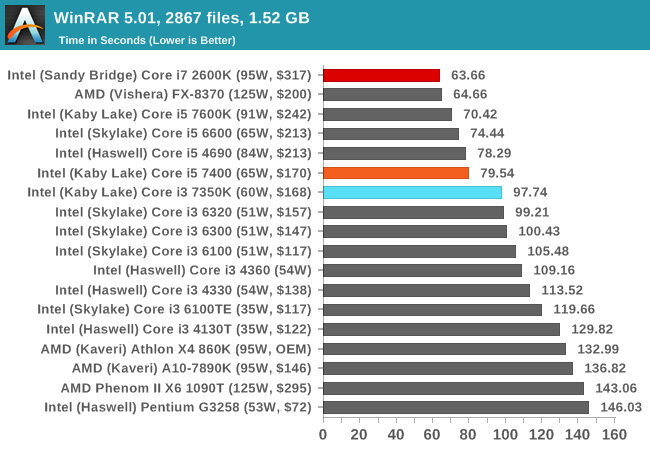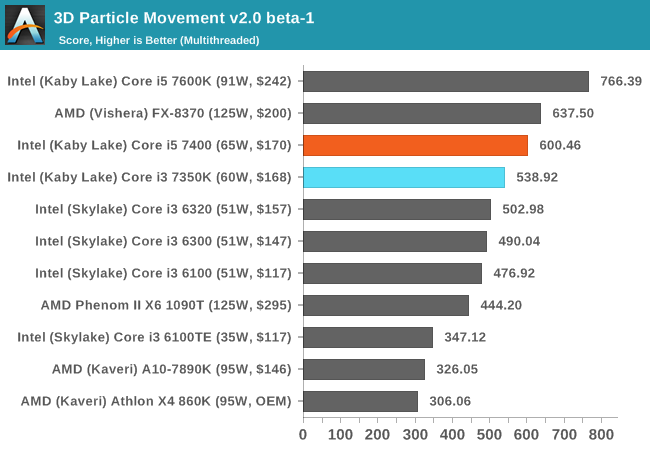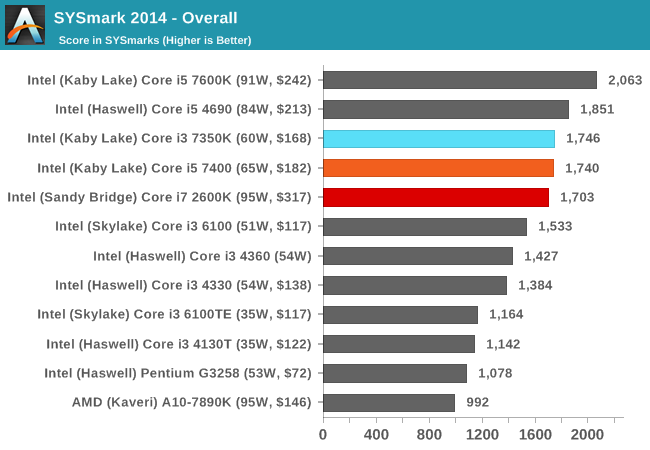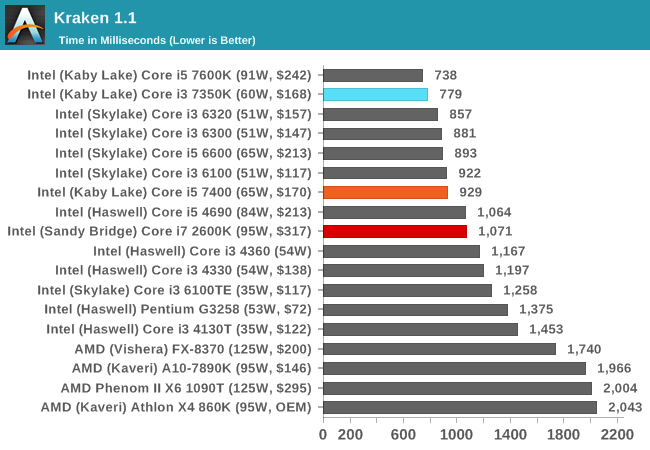The Intel Core i3-7350K (60W) Review: Almost a Core i7-2600K
by Ian Cutress on February 3, 2017 8:00 AM ESTOffice Performance
The dynamics of CPU Turbo modes, both Intel and AMD, can cause concern during environments with a variable threaded workload. There is also an added issue of the motherboard remaining consistent, depending on how the motherboard manufacturer wants to add in their own boosting technologies over the ones that Intel would prefer they used. In order to remain consistent, we implement an OS-level unique high-performance mode on all the CPUs we test which should override any motherboard manufacturer performance mode.
All of our benchmark results can also be found in our benchmark engine, Bench.
Dolphin Benchmark: link
Many emulators are often bound by single thread CPU performance, and general reports tended to suggest that Haswell provided a significant boost to emulator performance. This benchmark runs a Wii program that ray traces a complex 3D scene inside the Dolphin Wii emulator. Performance on this benchmark is a good proxy of the speed of Dolphin CPU emulation, which is an intensive single core task using most aspects of a CPU. Results are given in minutes, where the Wii itself scores 17.53 minutes.

The 7350K, with a high single thread frequency, easily surpasses the i5 and i7-2600K here. That being said, there's a slight difference to the Skylake i3, perhaps down to various generation specific code differences.
WinRAR 5.0.1: link
Our WinRAR test from 2013 is updated to the latest version of WinRAR at the start of 2014. We compress a set of 2867 files across 320 folders totaling 1.52 GB in size – 95% of these files are small typical website files, and the rest (90% of the size) are small 30 second 720p videos.

WinRAR is more geared towards a variable threaded environment but also memory speed. The fact that the Core i5 is above the Core i3 shows that having actual cores helps, regardless of frequency - the additional hyperthreads for the Core i7-2600K also gives it the win, despite the memory frequency difference.
3D Particle Movement v2
3DPM is a self-penned benchmark, taking basic 3D movement algorithms used in Brownian Motion simulations and testing them for speed. High floating point performance, MHz and IPC wins the day. This is the second variant of this benchmark, fixing for false sharing in the first version, and lending itself to better multithreaded performance.

3DPMv2 is still new, so we don’t have too many results for it so far - but again this is another situation where having actual cores helps. This is typically when the threads are 'heavy', i.e. spill out into various caches and require more than 1/2 the cache shared within a core each. In the case of the Kaby Lake, this means that each core has 32KB of L1 - or 32KB per thread for the i5 but only 16KB per thread in the i3.
SYSMark 2014
Engineered by BAPco (to which Intel is a consortium member), this set of tests are designed to be an office/data/media/financial range of tests using common well-known CAD, image editing, web browsing and other tools to put out a score, where a score of 1000 is attributed to an old Core i3 using a mechanical harddrive. Here we report the overall score, however the test breakdowns can be found in Bench.

Because SYSMark is a variety of tests that rely on response and throughput, here is where the Core i3 comes into play over the i5 and i7-2600K. With the i5 it's about equal, but the years of IPC increases put the i7-2600K now behind the Kaby i3.
Web Benchmarks
On the lower end processors, general usability is a big factor of experience, especially as we move into the HTML5 era of web browsing. For our web benchmarks, we take well-known tests with Chrome as installed by SYSMark as a consistent browser.
Mozilla Kraken 1.1

Kraken favors high frequency and IPC, so the i3 takes a large lead over the i7-2600K for this sort of workload.










186 Comments
View All Comments
Ian Cutress - Friday, February 3, 2017 - link
There are some minimum frame rate numbers in Bench, however they're not all regular (they're based on pure min, not 99%). The goal is to have some nicer numbers in our testbed update. Soon. When I find time to finish the script ... :Dfanofanand - Friday, February 3, 2017 - link
"This RGB fad that apparently sells like hot cakes"I love you Ian! In a totally hetero way.....
Seriously though great article, this should silence all the crybabies who whine about the lack of "Anandtech style in-depth analysis". You are still the best CPU reviewer in the biz!
jgarcows - Friday, February 3, 2017 - link
I'm still running an i5-2400 at default speeds that I paid $205 for when it first came out. It is insane how slow the improvement of intel chips have been. You'd think by now an i3 would be an upgrade.crashtech - Friday, February 3, 2017 - link
Frame times would be what hurts the i3 in games if anything. The averages may not be telling the whole story.djscrew - Friday, February 3, 2017 - link
Don't count on this being the new norm. Even though Intel just invalidated a long standing policy and the perception that these are inferior chips with this change I don't think it will lat. The next process shrink will likely bring with it a die size change leaving the i3 people who want to upgrade a few years down SOL. They could simply roll back this "feature" and we're back to status quo.fanofanand - Friday, February 3, 2017 - link
Your comment doesn't make sense. The next node will require a new chipset and ANYONE with today's mobos will need to upgrade, EVERYONE will be SOL.jaydee - Friday, February 3, 2017 - link
Conclusions page: "A good example of this is Agisoft: the Core i5-7400 (which costs $14 more, quad core, 3.4-3.8 GHz) completes the work ~10% quicker."Do you mean the i5-7400 @ 3.0-3.5 GHz, or the i5-7500 @ 3.4-3.8 GHz?
Ian Cutress - Friday, February 3, 2017 - link
Ah yes, I meant the 7400. I had 2600K numbers in my head at the time. :)name99 - Friday, February 3, 2017 - link
"and goes in line with the fact that Intel has officially stated that one of the key features of the new 14+ process is that the transistors are more ‘relaxed’ and there’s no decrease in density."Remember those days when Intel was slagging TSMC for no transistor scaling? Ah good times.
[img] https://www.extremetech.com/wp-content/uploads/201... [/img]
I guess TSMC just decided to "relax" their transistors...
name99 - Friday, February 3, 2017 - link
"The latest memory technology to hit prime time is Intel and Micron’s 3D XPoint. "Where "hit prime time" means "may ship some time in 2019"?
No-one cares about 3D XPoint in SSDs; and the DRAM version seems utterly MIA since the initial enthusiastic Intel claims. (Come to think of it, much like Intel 10nm ...)